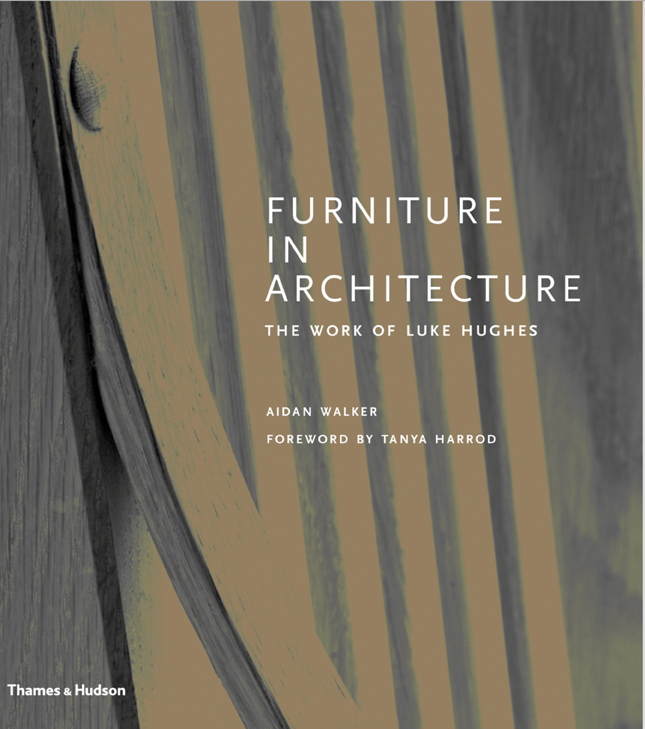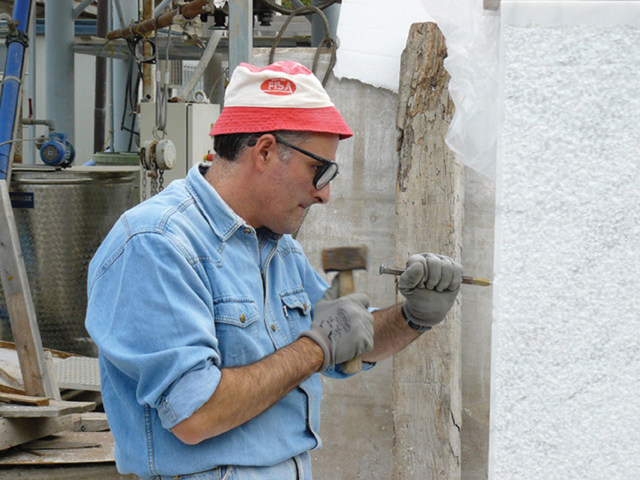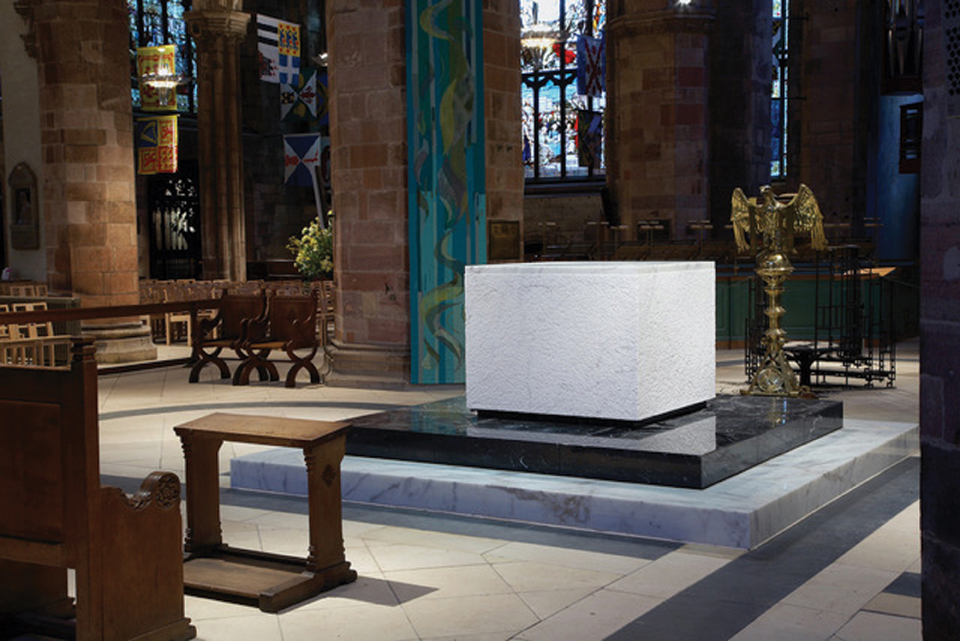On 16 September a book by Aidan Walker about the work of renowned furniture designer Luke Hughes was launched at the prestigious Messums Wiltshire gallery and arts centre in Tisbury. Here Luke talks about one of the projects in the book, the marble altar at St Giles Cathedral in Edinburgh.
 Furniture in Architecture: The Work of Luke Hughes
Furniture in Architecture: The Work of Luke Hughes
published by Thames & Hudson
Author: Aidan Walker
ISBN: 978 0 500 022542
Pages: 256
Illustrations: more than 400
Price: £48 (15% discount if you quote FURNITURE 15 at bit.ly/LukeHughes15)
Luke Hughes started out as a designer-maker of fine furniture and now runs the company of Luke Hughes & Company, which makes bespoke furniture for discerning clients. Luke and his company have been described as embodying a craft-led renaissance in British manufacturing in its explorations of the relationship between space, function, design, craft and a sense of place. The company has produced commissions for: 60 of the 68 Oxbridge Colleges (libraries, refectories and accommodation); The Tower of London; The Supreme Court, Ivy League universities and various synagogues in the USA; corporations such as Unilever and Diageo; devotional places of worship including Winchester Cathedral, Westminster Abbey and St Giles Cathedral, Edinburgh; and pioneering academic institutions in Asia such as the Keystone Academy in Beijing. Luke Hughes & Company’s furniture is an eloquent response both to the architecture it inhabits and to the Arts & Crafts spirit from which it evolved.
The author of the book, Aidan Walker, is an experienced cabinetmaker, editor of The Encyclopedia of Wood and a former editorial director of several professional design journals. The forword is by Tanya Harrod, one of the most highly regarded craft historians working today.
The book is not only or even mainly about the use of stone in furniture, although it does include stone, including the marble altar at St Giles that Luke talks about below.

Luke Hughes
“Ice-cubes,” said Mauro Rovai when I asked him how on earth we could get a four tonne gleaming white monolithic block of marble to ‘float’, right in the middle of the grey-green sandstone interior of St Giles Cathedral in Edinburgh.
The finished altar sits on an inset black stone plinth to give it the impression of floating, but the issue here was how to remove the lifting straps after it had been positioned on the plinth. “If we are to see no mortar lines, how do we get the lifting straps out?” I wondered.
Mauro had the answer. “Just go to Tesco’s. Buy two bags of ice. We lower the block on to the ice, take out the straps, then go and have lunch. Simple. Old trick. Michelangelo used it with the siting of some of his marble statues.”
Mauro’s intriguing answer went deeper, far deeper, than the familiar discussions about the tension between designing and making, especially for us since, as designers who specialise in designing furniture specifically for public spaces, predominantly for buildings of learning (universities and schools), buildings of worship (cathedrals, churches and synagogues) and buildings of work (institutions, livery halls, libraries).
Still, stone might not seem the most sympathetic material to use for furniture.
Over the past 40 years, we have designed furniture for the UK Supreme Court, Yale and Harvard Universities, 90% of the Oxbridge colleges, 24 of the major cathedrals in the UK and USA (including Canterbury, St Paul’s, Westminster Abbey, Ely, Exeter, Salisbury, Sheffield, Chichester, Winchester, Rochester and Bristol), nearly 200 parish churches and nine synagogues in the USA. So, perhaps we might be forgiven for claiming some experience about what makes these buildings both functional and inhabitable.
In our view, it is the furniture... what you touch and what you sit on... that proclaims the function of any architectural space and much of its meaning.
Timber is the material that makes up about 65% of what we normally use, the remainder being made with metals (ferrous and non-ferrous), resins and nylons. And, occasionally, stone.
Stone furniture? Can that really be right? Well, yes it can… think of the colossea in Rome, Verona or Nimes, or the Ancient Greek theatres like Athens, Dodona or Epidavros, with their hundreds of tiers of stone benches, ingeniously cut on the curve, perhaps the longest-surviving examples of stone furniture.
Others are the altars, pulpits and ‘cathedra’ (or bishops’ seats) in major cathedrals, like that in Canterbury dating back to St Augustine in the 6th century.
Thanks to new technologies, new techniques and new materials, the making of furniture has moved on enormously in the past 40 years, for workers in stone as much as for those using wood.
As someone who began life as a cabinetmaker, these days I feel entirely familiar with the machinery now available to a stonemason: the quarry chainsaws, the tungsten-tipped chisels, diamond-tipped bandsaws, the monumental circular saws, the milling/grinding/honing devices, hydraulic lifts, epoxy resins, aluminium honeycomb panels, waterjet cutting and CNC profiling. The scale of the equipment might vary but the principles of cutting, grinding and polishing are similar.
All of these technologies and techniques are a far cry from what I remember as a boy when, in the early 1960s, my parents began to rebuild and make habitable a ruined 17th century house close to the quarries of Chilmark, Chicksgrove and Tisbury in the South of England (now managed by the Lovell Stone Group).
Our neighbours over the adjoining wall were the stonemasons engaged in stabilising Old Wardour Castle (a 14th century ruin now in the care of English Heritage).
There were six or seven masons reconstructing the tree-embedded walls, making them safe for the public to roam between.
Their foreman, Mac, led them in taking down loose stones, removing the ivy and self-sown ash trees, and replacing the stone in new beds of mortar as well as pointing up what was already stable.
During school holidays I would watch them for days as they ingeniously moved the great stones about, wedging them against their squares and plumb-lines, back-filling with smaller stones, mixing, puddling and turning the lime and sand with just enough water to begin the chemical reaction but not so much as to cause shrinkage and cracking, flicking the stones with a wet brush to moisten the adjoining stones in order to draw in the mortar, watching how they split the stones or squared them up, how they selected them to over-sail the joints or how they trued-up the corners to set the bedding lines for the next course. Not much had changed since the castle was built in the 1390s.
After working hours, when the masons had gone home, I would scamper over the scaffolding and the ruined walls to explore the rest of the castle, squeezing through the underground tunnels and clambering over the turrets, dreaming about the rest of the building… trying to hear what those 14th century stones could tell me, eking out their stories – the mouldings, the mullions, thresholds, string-courses with their elaborate rose-cluster flowers, the interlocking turret steps, the flutings, the firebacks, the lintels... letting my fingers trace the carvings, pondering how the shadows they cast might change through the day.
There, amid this great treasury of silent tales, could be found the marks of the masons – the distinctive signatures of people whose names are forgotten; the identifying marks of individual members of teams of illiterate, itinerant geniuses, speaking to me from 600 years ago.
In those days, masons were paid for the stone they worked. They could be left alone by the foreman for weeks at a time and when he returned to settle their pay, they had to be able to point to the stones they had laid. Since they could not write, they marked the stones with a distinctive mark, so there was no argument who had done what.
But, like an artist signing a painting, their marks were also a mark of pride. There was often rivalry among masons to be best and lay the most stones. The men had an identity. They were not anonymous. Their marks still identify their work, even after all these years.
And then I went to the Cathedral School in Salisbury, founded in 1092 and still housed in the 14th Bishop’s Palace, directly under the shadow of the south-east corner of the Cathedral spire.
The Cathedral building seemed, even to an eight-year old, a sublime miracle, not just one of astonishing beauty but also of technical brilliance.
Hundreds of thousands of tons of stone, mostly quarried close to my home but worked with even more ingenuity and gusto than I’d seen in the clunkier masonry at Wardour. The stones hovered, shimmered, soared, defying logic, responding to the craftsmen like an ethereal cobweb – the columns, capitals and mouldings, the delicate volutes, the flying buttresses, the lierne arches, the complex geometric projections, the statues and porches, the complex lunettes of the cloisters, the textures of chiselled, carved and polished stones. And it is indeed the texture... what you touch and examine close-up... that makes these buildings sing.
I mention all this since there is a danger that the dead hand of the machine that now results from the new technologies, with their perfect milling thanks to the diamond-tipped tooling of CNCs, sucks the poetry from the stones.
This is an old argument; one that prompted the founders of the Society for the Protection of Ancient Buildings (SPAB) and the Arts & Crafts Movement from which it blossomed in the late 1800s, to rebel against the unsympathetic machine restorations of Gothic Revival architects like Gilbert Scott, Butterfield, Street and Bodley.
Moreover, it is an argument that is still relevant today. One of the questions that exercised the rebels was ‘how do we teach those machines some manners’?
The truth is there’s no substitute for finishing by hand. We should never underestimate the emotional response evoked by materials that have been knowledgeably selected, accurately executed but, above all, dressed, finished and humanised by the hand of a skilled craftsman. That brings it all to life.
When it came to the Holy Table at St Giles Cathedral in Edinburgh, marble was the material of choice because of its luminescent quality and its association with high value.
The first research led me to explore the tiny Hebridean island of Iona, which St Columba used in the 6th century as a base to spread his brand of Christianity in the far north of the land mass that is now Great Britain.
I discovered the marble workings at Iona had been defunct since the First World War and, although large blocks of the stone still remained on the seashore, they were so weathered as to be rendered useless.
It would have been technically possible to re-open the quarry – although not, perhaps, to revive the machinery abandoned in 1914 and still onsite – but overcoming the logistical challenges involved were beyond the budget.
 Marble mason Bertozi Felice hand finishing the altar.
Marble mason Bertozi Felice hand finishing the altar.
The obvious next stop was the area around Carrara, its name synonymous with marble, where the challenge of finding a single, four-tonne block of the finest quality without flaws was taken up by Mauro Rovai and his team.
It was agreed to use a single white block of Calacatta marble, which would float above a plinth and steps of Nero Marquinha, with its white veins on a black background, set on another layer of Calacatta.
I wanted it to gleam; to stand out as a focus of light in the rather gloomy interior.
It needed to shine, but not with that vulgar sheen that you get in hotel foyers. It needed not just to shine but to sparkle; to throw light.
The dressing was going to be key to the rhythm and harmony of the whole ensemble.
The aim was to get the top to be smooth, as if it were emerging from a rusticated bedrock, like Michelangelo’s ‘prisoner’ figures.
In this way, in discussion with craftsmen, the distinctive hand-tooled finish was developed for the vertical surfaces.
It took one of the craftsmen more than a fortnight’s solid work with a single diamond-tipped chisel to achieve the effect.
For designers, it is in this understanding of meaning, method and metaphor, combined with an understanding about when best to deploy the skill of hand, eye and heart (and not just the technology) that results in work that can put the poetry back into the stones.

